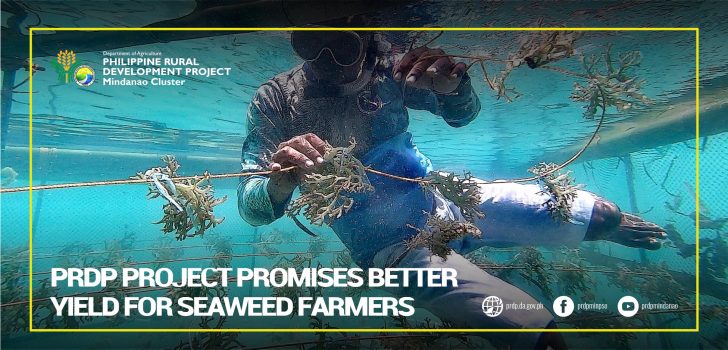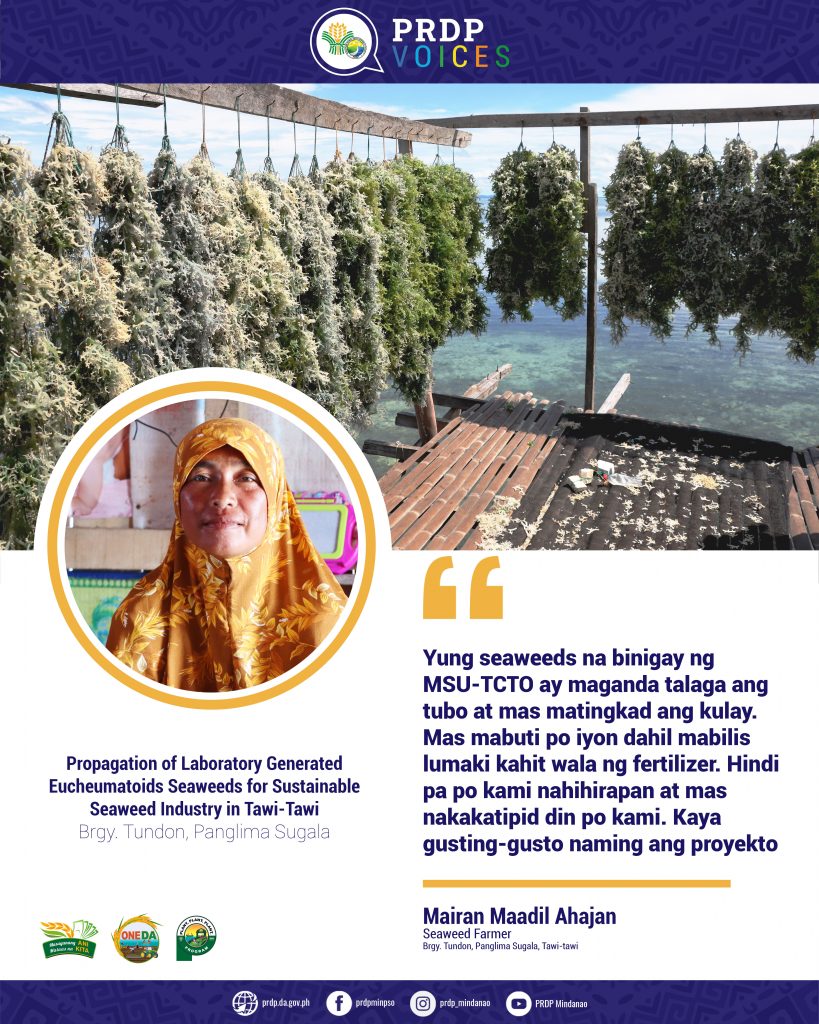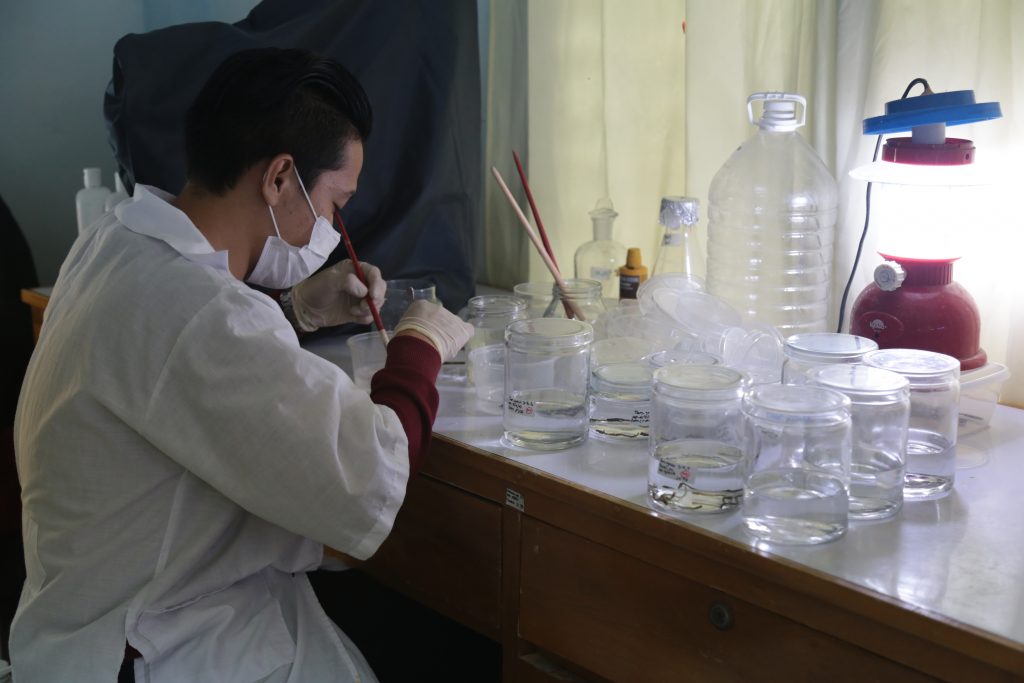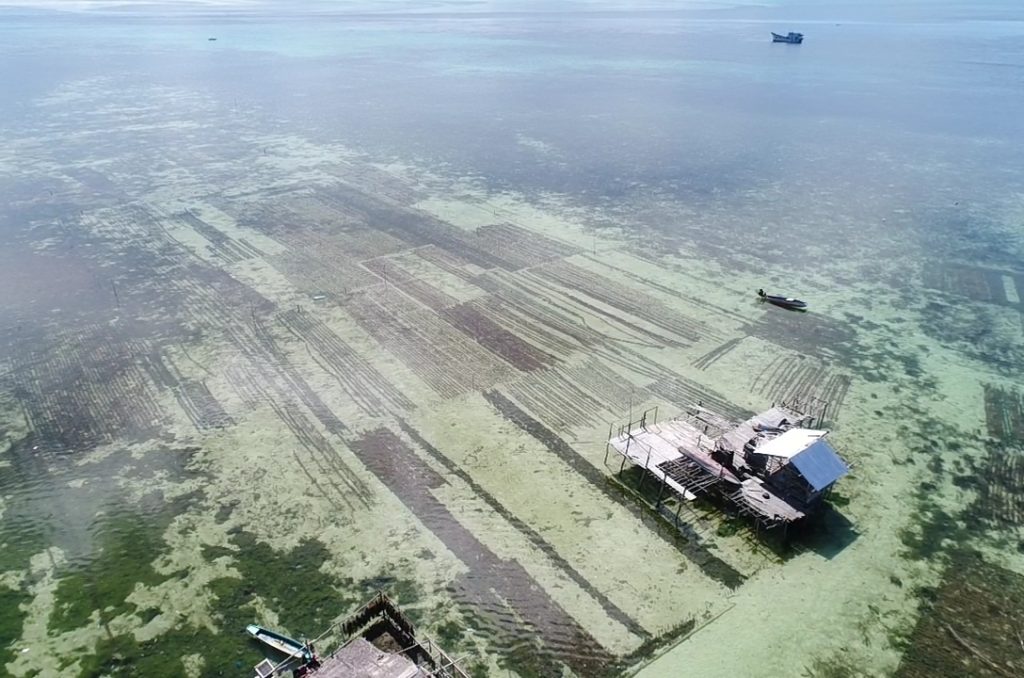
PRDP Project Promises Better Yield for Seaweed Farmers
With the support from the Philippine Rural Development Project (PRDP), the Mindanao State University of Tawi-tawi was able to establish a seaweed nursery and produce a ready supply of laboratory-generated seaweed seedstock to allow for sustainable farming in Tawi-Tawi.
Better Yield for Farmers
Seaweed farmer Marian Maadil Ahajan, a beneficiary of Phase 1 of the PRDP supported seaweed project, said that the seedlings from MSU were very good because they could grow fast even without the use of fertilizers.
“The seaweed given to us by MSU was really different from what we used before,” said Ahajan. “It grew faster compared to the seaweed we were before which needed fertilizer to grow. In terms of seedlings, we could make seven (7) to 10 lines from the seedstocks from MSU, while the seedlings we used before could only reach up to three (3) lines.”

According to Professor Karen Joy Serag, technical assistant in-charge of the seaweed cultivars laboratory, there was a recorded difference in the growth rates of the seaweed cultivars from the laboratory compared to those currently used by farmers in Tawi-Tawi.
“Based on the methods we used, which is micropropagation or tissue culture, the lab-grown seaweed had a high survival rate when transferred into our land and water-based nurseries. It has a daily growth rate of 4% compared to the cuttings currently used by the farmers here which only have a 1.5 to 2.5% growth rate,” said Serag.
Bringing Technology to More Communities
Now in Phase 2 of the project, MSU aimed not only to provide a sustainable source of quality seaweed seedlings to farmers but to address one of the biggest problems nowadays—the rampant use of fertilizer in seaweed farming.
Project Leader and Director for the Office of Continuing Education and Extension Services (OCEANeS) Richard N. Muallil said that there were many negative effects recorded with the use of fertilizers among seaweed farmers.
“Aside from the negative effect on the environment, farmers now need to spend more time farming because of the constant need to monitor their seaweeds and apply fertilizer. Also we have observed that their seaweeds are now more susceptible to diseases making farming costly and laborious,” said Dir. Muallil.

(From left) Planning Officer Abdeel Rauf Tending, Writer Joy Montecalvo, Associate Procurement Officer Sheryl Baganian, Planning Officer Elsie Omandam, Dir. Richard Muallil, PhD, Planning Officer Shiela May Ibasco, and Planning Specialist Elden Karl Requilme.
With plans of producing good quality seaweed for planting, MSU piloted the project in Barangay Tundon in Panglima Sugala which is a small coastal community surrounded by marine protected areas where 80% of the people rely on farming seaweeds as their main source of income.
PSO Mindanao IPLAN Component Head Cerenio Tila said that this partnership with MSU TCTO is part of the convergence initiative of PRDP.
“In PRDP, we always look at the value chain and we have this convergence initiative involving other line agencies in order to address the gap. In this project with MSU-TCTO, we want to provide support to enhance the delivery of technical service to the seaweed industry in Tawi-tawi,” said Cerenio Tila.
The residents of Brgy. Tundon, led by Brgy. Chair Nadzmil H. Mantik, showed all-out support to the project by monitoring the seaweed nursery.
“The community is very supportive. In fact, when we marked the boundaries of the area they allocated for our nursery, we were surprised that it reached 23 hectares. This area used to be their traditional seaweed farms,” said Dir. Muallil.
Negative Effects of Fertilizer Use
Unfortunately in the past couple of years, this age-old farming ground has become idle. One of the reasons for this, according to Dir. Mualil is the use of fertilizer for farming. Farmers now need to place their seaweed farms closer to their homes because of the need to monitor every day. Gone were the days when, after planting, farmers could leave their seaweeds and check on them again during harvest season.
Brgy. Chair Mantik saw how practices in seaweed farming shifted through time.
“Our major problem since we started using fertilizers is the number of hours we have to spend on farming seaweed. Back then, we only had to concern ourselves with planting and harvesting. Now, we have to spend more time because we need to apply fertilizer before planting, then “recharge” it by applying fertilizer again after a few days or else our seaweed would die,” said Mantik.
According to Mantik, farmers’ health is also at risk because of chemical use and long hours of work. He added that farmers are also burdened by the additional cost of having to use fertilizer.
“Our expenses tripled from the usual P1,000 to P3,000 because we need to include fertilizer and more planting materials. Seaweeds exposed to fertilizer are only good as seedlings for two planting cycles while, prior to fertilizer use, we could use the cuttings five times,” he added.
Wider Access to Seaweed Stocks
MSU has already begun planting in the sea-based nursery to increase the production of quality seaweed seedstocks for distribution in Brgy. Tundon, with plans of expanding to other municipalities such as Sibuto, Sitangkay, and Tandubas.

“The very objective of this project is really to help the seaweed farmers in their livelihood,” said Dir. Muallil. “We want to give them superior quality seaweed seedstock that they can use in planting which will help not just the farmers but the entire seaweed industry here in Tawi-tawi.” (Joy M. Montecalvo, PSO Min)


